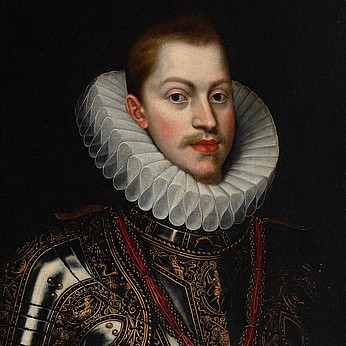JUAN ANDRÉS RICCI (Madrid, 1600-Montecassino, 1681). "La Moreneta". Oil on copper.
Lot 86
About Seller
Setdart Auction House
Carrer Aragó 346
Barcelona
Spain
Setdart Subastas was born in 2004 and is currently the first online art auction in Spain with solidity, prestige and reliability guaranteed by our more than 60,000 users. Setdart has a young, dynamic and enterprising team ready to successfully manage the purchase and sale of art works through custom...Read more
Estimate:
EUR€8,000 - EUR€9,000
$8,602.15 - $9,677.42
Absentee vs Live bid
Two ways to bid:
- Leave a max absentee bid and the platform will bid on your behalf up to your maximum bid during the live auction.
- Bid live during the auction and your bids will be submitted real-time to the auctioneer.
Bid Increments
| Price | Bid Increment |
|---|---|
| EUR€0 | EUR€10 |
| EUR€200 | EUR€25 |
| EUR€500 | EUR€50 |
| EUR€1,000 | EUR€100 |
| EUR€3,000 | EUR€200 |
| EUR€5,000 | EUR€500 |
| EUR€10,000 | EUR€1,000 |
| EUR€20,000 | EUR€2,000 |
| EUR€50,000 | EUR€5,000 |
About Auction
By Setdart Auction House
Nov 24, 2021
Set Reminder
2021-11-24 09:00:00
2021-11-24 09:00:00
America/New_York
Bidsquare
Bidsquare : Old Masters, Day 1
https://www.bidsquare.com/auctions/setdart-auction-house/old-masters-day-1-7873
Setdart Auction House sofia@setdart.com
Setdart Auction House sofia@setdart.com
- Lot Description
JUAN ANDRÉS RICCI (Madrid, 1600-Montecassino, 1681). "La Moreneta". Oil on copper. Measurements: 16,5 x 13,5 cm. The painter Juan Andrés Ricci entered the Benedictine monastery of Montserrat in 1627 to study theology. His intellectual development went hand in hand with his pictorial evolution. Here we see a representation of the Virgin of Montserrat (the Moreneta) with the child on her lap, as in the original sculpture, although the painter adds sumptuous crowns and bunches of lilies. Behind the Maternity, the unique mountainous orography has been represented following Flemish models, as can be seen in the use of rich blue and cerulean shades, and in the botanical detail. Painter and theoretician, he belonged to a family of artists, son of the painter Antonio Ricci de Ancona, who came to Spain to work in El Escorial with Federico Zuccaro and who stayed definitively in Madrid, and brother of Francisco, painter of the king in 1656. He must have been educated with his father, although Palomino makes him a disciple of Maíno. This treatise writer also speaks of the success of his paintings at court. However, Ricci left the court to enter the monastery of Montserrat. From the moment he entered the Benedictine order, he began his intellectual instruction, which was obligatory for the followers of Benedict of Nursia. He studied theology in Irache and law in Salamanca. All this will provide him with an authentic erudite knowledge that he will exploit in his writings on art. A connoisseur of several ancient and modern languages, he will claim, very much in line with the times, the liberality of painting, especially in his treatise La pintura sabia (1660-1662), dedicated to the Duchess of Béjar. This text follows the tradition of Alberti by requiring the painter to study geometry, perspective and anatomy, to which he adds the essential role of painting as a disseminator of the religious image, turning the painter into an emulator of the Deus pictor. All this is accompanied by beautiful drawings in which he also shows his knowledge of architecture. In 1641 he was already outside Montserrat and, after being appointed professor of drawing to Prince Balthasar Charles, he was removed for political reasons. From then on he made several trips to the Castilian monasteries of the order, which he combined with stays in Madrid. He did not stop working as a painter in all of them. The best preserved sets of the artist are those of San Millán de la Cogolla and the trascoro of the cathedral of Burgos. In 1662 he moved to Rome, where he remained for several years, coming into contact with Pope Alexander VII and Christina of Sweden, to whom he dedicated a new architectural work. In 1667 he is already in the famous monastery of Montecassino, where he will continue to work both in painting and writing. His painting evolves very little, remaining far from the novelties that are imposed at court or those that he will know later in Italy. Although his brushwork is loose and reflects a great freedom of touch, the most successful aspect of his work is the great severity of the characters in his monastic cycles. To this we must add the exceptional portrait of Fray Alonso de San Vítores in the Museum of Burgos.
- Shipping Info
-
In-house shipping available. Please inquire at admin@setdart.com.
-
- Buyer's Premium



 EUR
EUR CAD
CAD AUD
AUD GBP
GBP MXN
MXN HKD
HKD CNY
CNY MYR
MYR SEK
SEK SGD
SGD CHF
CHF THB
THB













